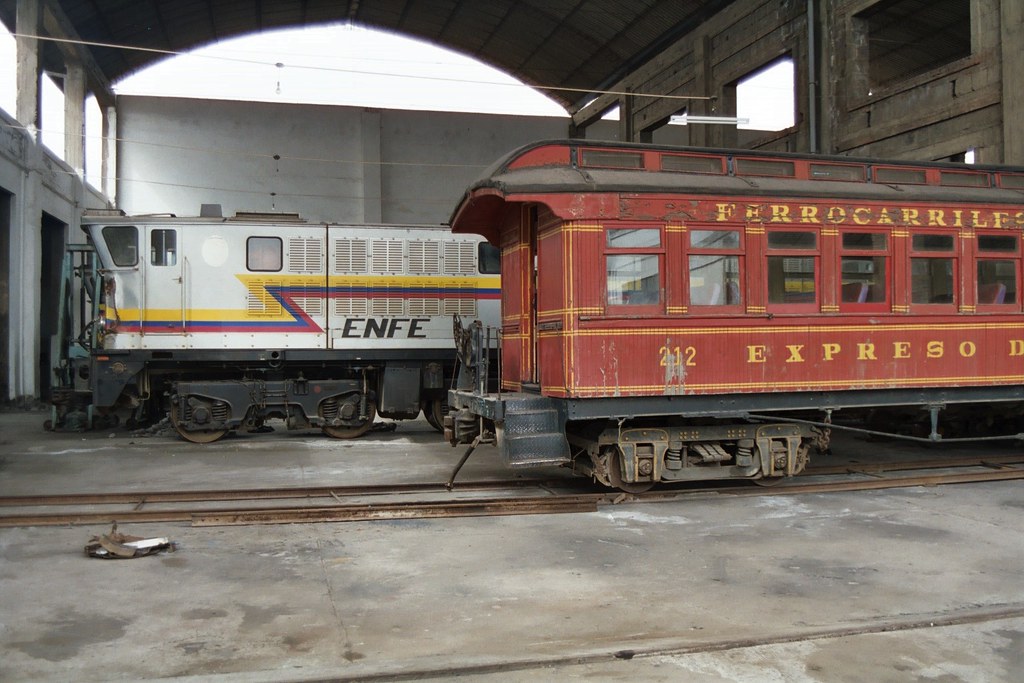#alsthom
Note
tell me about french train headlights
They're all the same! Or at least they were, from the mid-1950s to about the early 1990s. They all look like this:
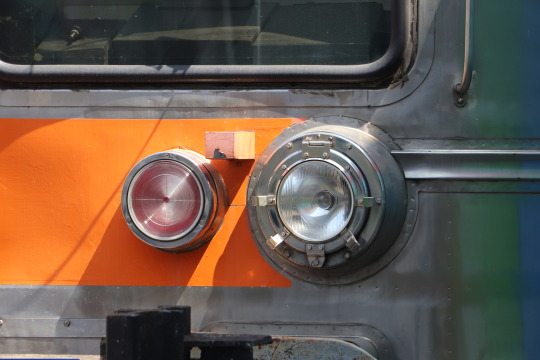
Okay, some context for why I find this interesting. Suppose you see a picture of a train, especially one made in the second half of the 20th century, and you want to know where the train is from. The key trick to telling this at a glance is having a bit of autism, but more specifically, the headlights.
In Europe, all major and many minor countries used to have their own government-owned railroad and their own train-building industry, which would build trains to the specifications of their railroad company. There has always been some exporting going on, but for the most part, the trains you'd find in Germany, France, Switzerland, Austria and so on would be all completely different. This has changed drastically over the past 20ish years.
One thing about this old model is that railroad companies would standardise certain parts within their fleets, especially small parts that need servicing and replacing every now and then. It saves on how many different types of spare parts you need to have.
Headlights are the most notable among these by far: Every train needs to have some of them. All trains have basically the same requirements for their headlights, no matter how fast or slow or whatever they are. Before LEDs, you needed to service the headlights regularly to replace the light bulbs, and as glass parts at the front of a fast moving vehicle, they can get damaged, so spare parts logistics are an issue. And most importantly, we as railfans can easily see them. So you get something like this:
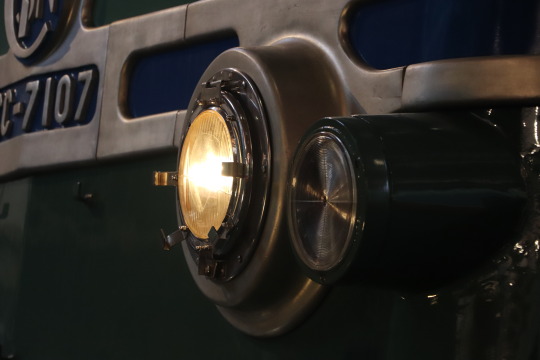


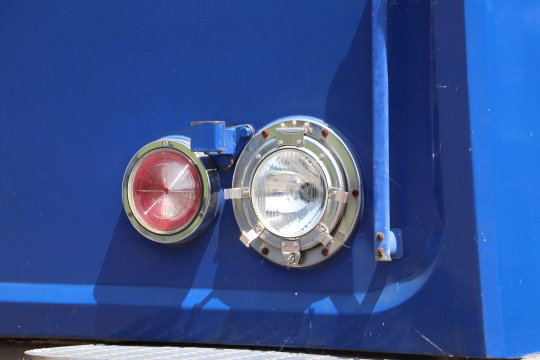
As a result, basically all railroad companies in post-war Europe standardised their head- and taillights for all or most of their trains. And all of them had completely different ideas. Fundamentally, all of them agreed that you need white headlights and red taillights, and since modern trains are easily reversible, you put both of them next to each other.
But do you make the white and red lights the same size (West Germany, Netherlands) or different sizes (Austria, East Germany)? Are they separate things, or do you combine them into one assembly (UK, Switzerland)? Do you make them anything approaching normal sized or gigantic (Poland)? Maybe I'll do an overview post over these later, but I don't have enough pictures in my library right now and I'd have to scour Wikipedia for them later.
The French headlight design shown here is in many ways just one of many, but also interesting in its own right: The actual lenses for red and white are the same size, but the white headlight gets this huge lens assembly that makes it look much more prominent. You can clearly see that different French designers had very different ideas about whether you the center-lines (most of them), or the bottom of the lens assembly. Why is the headlight lens so big, and what are the metal was around the bottom half of the circle? I have no clue. My guess is to put some coloured glass panes in, but I have no idea why you'd need that. Also, note that the red taillight classically has a fresnel lens, that's unique as far as I can tell.
I've taken all these pictures in the Cité du Train, the big central French railroad museum in Mulhouse. (That's why I was posting about traveling to Basel early this weekend. Mulhouse is actually really close to Basel, and going via Switzerland is the most practical—and most scenic—route for me) The oldest locomotive I could find with these headlights was CC-7107:

During high speed trails in the early 1950s, this locomotive reached a speed of 326 km/h (203 mph). That made it only second best behind the other locomotive at the trials, BB-9004:

This one reached 331 km/h (206 mph), a world record that would not be beaten for a long time. The difference was nothing to do with technical performance. Instead, both locomotives melted their pantograph, the part on top that touches the overhead line to get power, at around 320 km/h (200 mph). BB-9004 had a second one that it could lift up to continue accelerating, while CC-7107 only had the one. For a long time, SNCF pretended that both locomotives had reached 331 km/h, to protect the reputation of both manufacturers.
What's notable for our purposes is that BB-9004 has different headlights. As far as I can tell, these seem to be an earlier standard design, also found e.g. on the CC-65001 diesel locomotive:
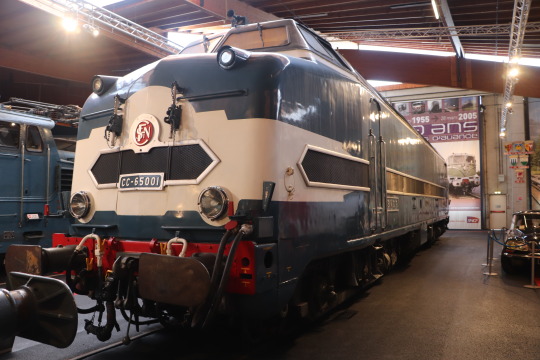
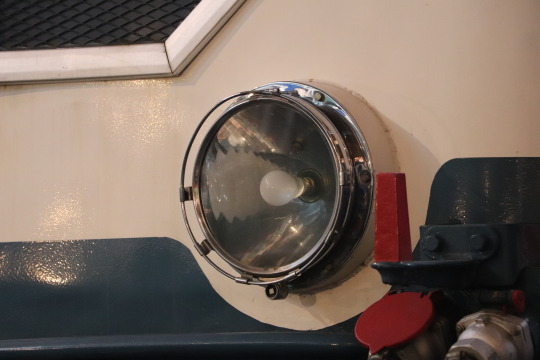
And even on steam locomotives, like this class 141 R:

So CC-7107 lost on the high speed world record, but it was the way of the future when it came to headlights. These headlights then started cropping up everywhere. From the detail pictures I've shown you above, we have e.g. Le Petit Gris (the small grey one, an EMU for suburban services in Paris):

A CC-6500, dressed up with a nameplate for the express train it was hauling. Fun fact: One locomotive of this type (not this one) was used in the US for a while, as Amtrak was trying out new electric locomotives to use. They weren't happy with it and bought a Swedish one instead, mostly because this locomotive's suspension did not work well with the American track quality.
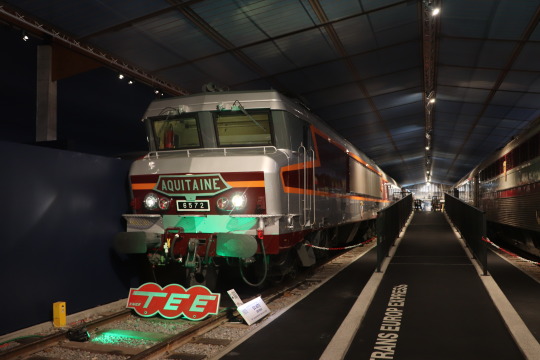
A Z 2200, a diesel railcar for rural lines designed to be cheap first, second and third.

A BB-26000, which feels altogether way to new to be in this museum.
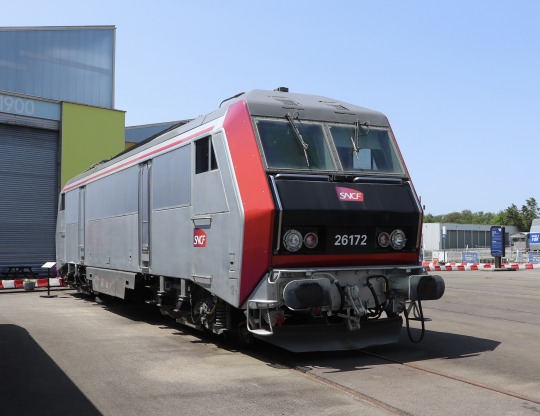
It's from the 1980s, so I guess the first are reaching retirement age. But at the same time: The train I took from Basel to Mulhouse was still pulled by one of these BB-26000.
Other favourites include the BB-25600 with its rare diagonal light arrangement:
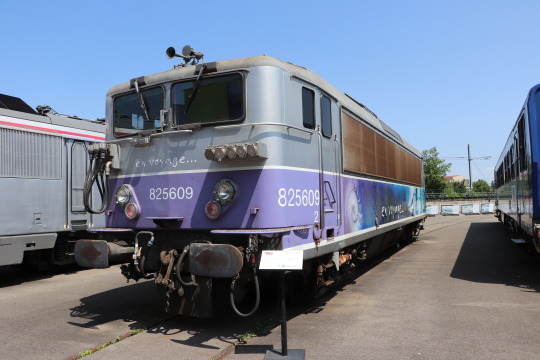
Or the really terribly lit gas turbine train RTG, which puts the headlight on stalks:
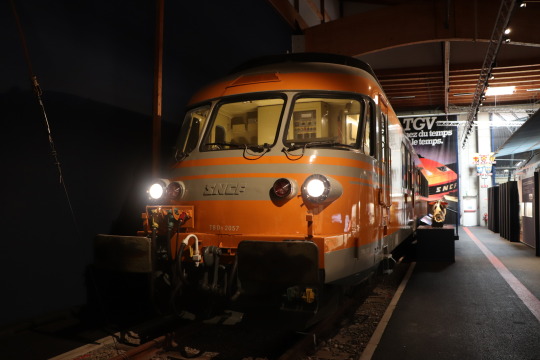
Fun fact: Amtrak did end up buying a few these. They didn't use the same white headlights (although they did use the same stalks), but they did use the same fresnel lens red taillights.
And the headlights went all the way up to the top. To the TGV. Only these headlights aren't very aerodynamic, so for their high-speed train, SNCF decided to cover them up.
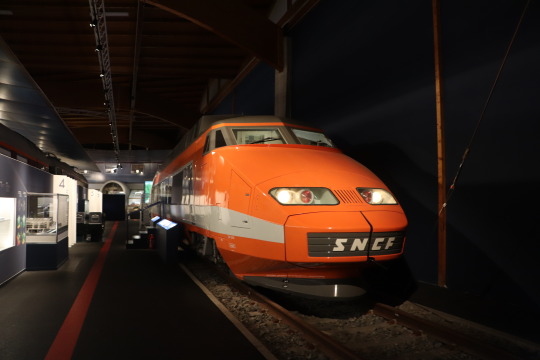
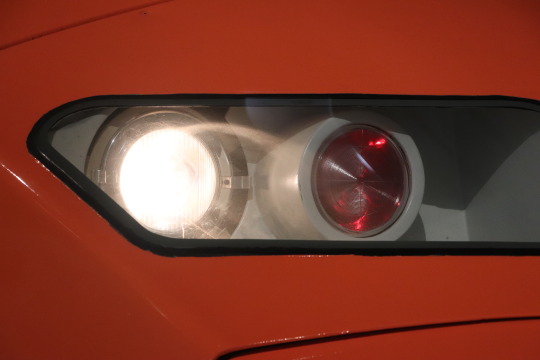
As far as I can tell, SNCF used these headlights in the TGVs up to the Réseau series, including the Eurostar. That meant that they're also found, though behind faded glass, on the TGV Atlantique 325 in the outdoor area. Number 325 is notable because it was involved in another high speed trail, and reached 515.3 km/h (320.3 mph) on May 18th, 1990.

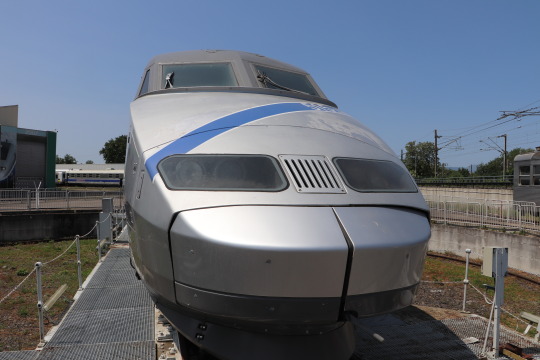

That was a world record, of course; in fact only the French ever exceeded 500 km/h on conventional railroads. So these headlights did get their world record after all. They didn't get to keep it for long, though. In 2007, a newer TGV reached 574.8 km/h (357.2 mph). That one is still in service, though, and it was equipped with newer LED headlights. I think it's highly unlikely that this record will be broken anytime soon, but if anyone does, I wouldn't be surprised if it were the French again, they like that sort of stuff.
Some final odds an ends with the headlights, though: Here's CC-40101, which isn't actually relevant, I just like the way it looks.

Designed for service in France, Belgium, the Netherlands and Germany, with four different voltages and four different train control systems, and that with mid-1960s technology. It wasn't quite as successful as hoped, and in service it only ever reached Belgium, but still, look at that design. The front is supposed to evoke an athlete, a sprinter about to start, but this type of design has instead become known as "Nez cassé", broken nose.
BB-9291 shows a rare early version without red tail lights at all. Someone thought they were saving money.
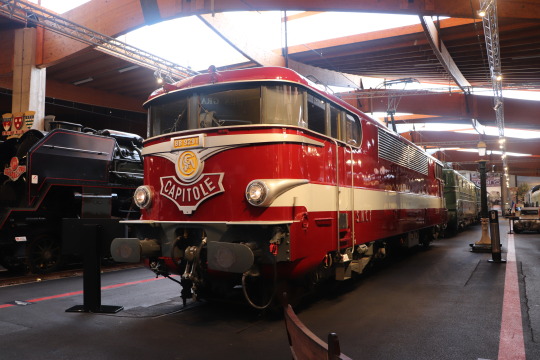
This small work train has a free-standing version of the headlight, which shows us how deep it really is. Apparently, the French headlight is actually not that deep, and isn't that a nice summary for this post?
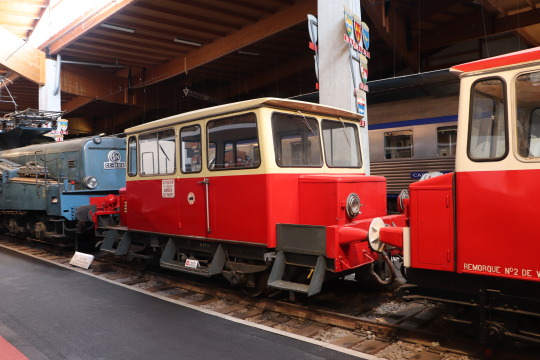
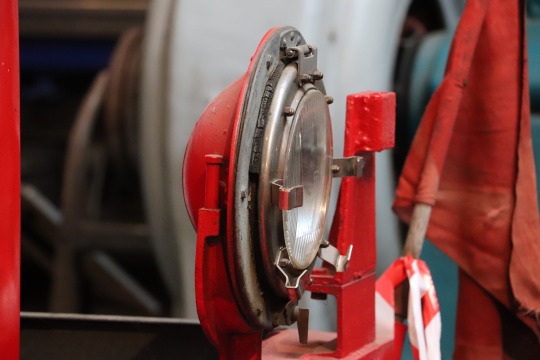
And a personal favourite of mine, I even bought a T-Shirt with it on it, the Z 600:
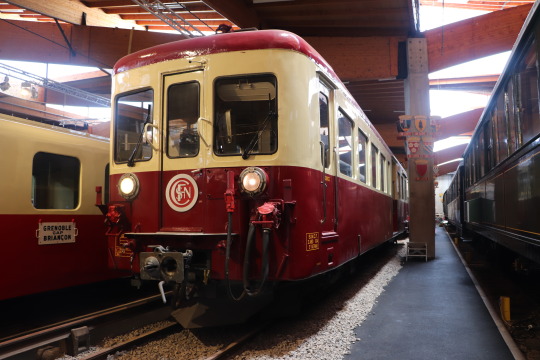
The design, in particular the side windows (recessed instead of flush, no outside visible gasket) says Swiss, the headlight and SNCF logo says French, it's narrow gauge and it has a third rail to provide power. Just all around a weird little train, for the weird little line known as the Mont-Blanc Express from France via Switzerland to the bottom of the Mont-Blanc mountain. The train was built in Switzerland, experts of building small trains for mountains, but for the French part of that rail line, so it got French headlights.
Headlights with exporting is a fun topic in its own right. Do you keep the headlights from the country of origin, or demand your own? You will find both approaches. Both Portugal and the Netherlands bought very similar electric locomotives from France. Portugal has French headlights, the Netherlands insisted on (less interesting) dutch ones.
These days, of course, you will still find these headlights, but they're getting rarer. They stopped being used in new trains around the mid-1990s. What's more, the ones you do find, like on this MI-84 in Paris, probably don't have the fresnel lens taillight anymore. Instead, those were replaced with LEDs.

LED lights for railroads make a lot of sense. They last forever and require less power. And since most railroads have standardised their head- and taillights, you just need to design one replacement light for most of France, and then keep building that one until SNCF stops giving you money.
(Since we're showing a picture from Paris, a quick note: These headlights were never used on passenger-carrying trains for the Paris metro. However, some work trains do have them.)
These days, standard headlights are completely gone. LEDs don't need a lot of replacing, and they give you much more freedom to do things like shapes and patterns and designs. Also, we don't have the "one country, one railroad, one rail industry" pattern anymore. Instead now we have multi-national rail conglomerates. Alstom is technically French, but arguably just as much German, ever since they bought Bombardier's rail division, nominally Canadian. Stadler is Swiss, except for the stuff they build in Germany or Poland or Belarus or Hungary or…, and some of their most interesting products right now are built and designed in Spain.
The end result of that is this:
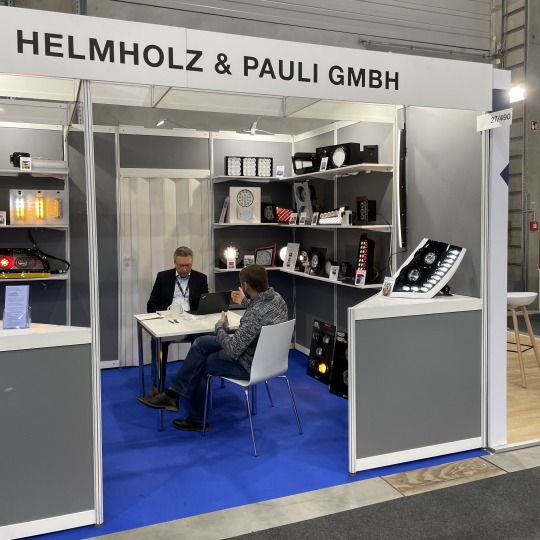
That's a company I saw at a trade fair (Innotrans, Berlin, 2022) that makes LED train headlights, and specifically they make… all of them? Okay, I'm exaggerating, but this is a great picture to drive a European rail fan insane as they try to assign the different headlights to different trains. You get Stuttgart trams, German (and Turkish) high speed trains, lots and lots of Swiss stuff. Nothing specifically French that I could tell, but at least the German high speed train regularly travels to Paris.
The standard headlights, or their LED variants, were still in use for work trains until fairly recently. There are not that many companies that make rail grinders or ballast tampers, and those tend to just use whatever headlight their customer tells them to. But these days they go for shaped LED headlights as well, because they're just better, and because thanks to European standardisation, a headlight approved in one country can (generally) be used in all European countries.
(All pictures © me, feel free to use them under CC-BY-SA 3.0 DE if you want)
55 notes
·
View notes
Video
Medway 1903 - Eva by Sérgio Batista
Via Flickr:
1:45 Scale NEZ Cassé LEGO Replica of the former CP1903, 1903 is the only Locomotive on the Medway fleet with this "Pikachu" color, that is what make her unique. I called Her, because it was baptize with the female name "Eva" The 1900 class locomotives were built by Sorefame in Portugal under licence from the French company Alsthom and are visually similar to SNCF Class CC 72000
13 notes
·
View notes
Text
Movimento teme pelo futuro do comboio histórico do Vouga
O Movimento Cívico pela Linha do Vouga (MCLV) admitiu temer pelo futuro do comboio histórico do Vouga após tomar conhecimento de que a composição não circulará na época de Páscoa, depois de ter sido criado há sete anos.

"Se no presente ano a não realização da temporada de Carnaval já foi motivo de preocupação, a não realização da temporada de Páscoa faz soar todos os alarmes", referiu o MCLV em comunicado enviado à agência Lusa.
O movimento disse estar convicto "de que se nada for feito em contrário, o projeto Comboio Histórico do Vouga corre sérios riscos de ter os dias contados".
Segundo o movimento, a CP - Comboios de Portugal confirmou "que não irá haver temporada de Páscoa, argumentando falta de condições".
A Lusa enviou questões à CP acerca do comboio histórico do Vouga e aguarda resposta.
De acordo com o MCLV, "nos últimos meses de 2023, foi detetada uma grave avaria na caldeira da locomotiva a vapor CP E214, tornando-a inoperacional, e sabe o MCLV que só com grande resiliência por parte do pessoal da manutenção da CP é que foi possível a realização da última temporada de Natal do Comboio Histórico, desta vez com recurso à locomotiva a diesel".
O movimento referiu que "a CP está a ter problemas em reunir as condições necessárias para avançar com a reparação da caldeira da locomotiva a vapor", já que "os custos dessa reparação são extremamente avultados, e, segundo consta, está a ser difícil encontrar uma resposta junto da indústria nacional".
"A solução poderá mesmo passar pela aquisição de uma nova caldeira no estrangeiro. No entanto, esse processo será moroso", podendo também a CP recuperar "uma outra locomotiva, tendo em vista a sua readaptação para a queima de gasóleo, à semelhança do que já acontece com a locomotiva CP 0186 e que é utilizada no Comboio Histórico do Douro".
O comboio histórico do Vouga começou a circular em 2017 com recurso à locomotiva diesel Alsthom CP9004 e três carruagens dos primeiros anos do século XX, tendo sido adicionadas, entretanto, mais carruagens, como as napolitanas dos anos 30, que estavam na Linha do Tua.
"Nos finais de 2019, a recuperação da locomotiva a vapor Henschel & Sohn CP E214 foi a cereja no topo do bolo", recordou o movimento, que referiu que mais material recuperado está em Contumil (Porto) à espera de ser colocado na Linha do Vouga, algo que ainda não aconteceu por falta de espaço de armazenamento em Sernada do Vouga, apontou.
O movimento cívico reconheceu "o empenho, a bravura e até a paixão que o Município de Águeda e a equipa de Manutenção/Comboios Históricos da CP - Comboios de Portugal têm demonstrado ao longo dos tempos para manter este projeto sobre carris, mas neste momento está claro que isso já não é suficiente".
Para o MCLV, "há que trazer mais entidades para este projeto, sejam elas empresariais ou da sociedade civil, envolvendo todas as autarquias servidas pela linha".
"Será bastante embaraçoso para a região de Aveiro não apresentar um dos seus maiores produtos turísticos num ano em que a sua capital de distrito é também a capital portuguesa da Cultura", considerou o movimento.
Assim, o MCLV apelou aos municípios de Espinho, Santa Maria da Feira, São João da Madeira, Oliveira de Azeméis, Albergaria-a-Velha, Águeda e Aveiro para que "salvem o comboio histórico do Vouga".
0 notes
Text
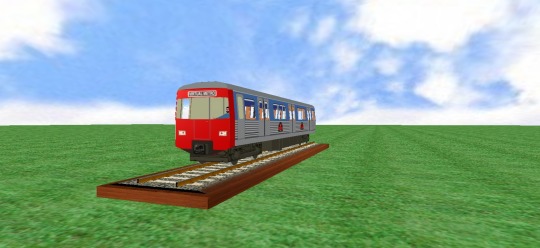
The ML79, based on RATP's Metro Paris MF-77 (PHOTO BELOW), was the second series of rolling stock used on the Lisbon Metro, inaugurating a sequence of material with a very similar appearance, all designed by the French company Alsthom-MTE. It entered circulation on January 1, 1984. A total of 56 carriages (numbering M101 to M156) were acquired between 1984 and 1989. They had a capacity of 164 people and reached a maximum speed of 72 km/h. They had an outer body in brushed stainless steel, manufactured at Sorefame, with a stripe painted in blue and front painted in red; the interior was in wood and blue tones, and the seats were blue. The ML79s were withdrawn from circulation on July 11, 2002. Their sale to the Buenos Aires Metro (SUBTE) was considered, but, when this deal failed, all carriages in the series were sold for scrap, with two later being rescued. carriages for exhibition.
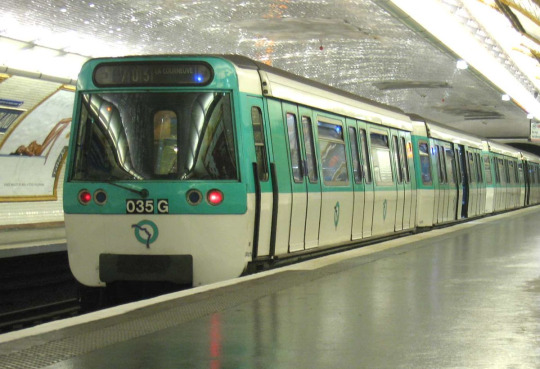
0 notes
Photo

🔴 ⬇️ ÖFFNE DIE BESCHREIBUNG ⬇️ 🔴 ▪️▪️▪️▪️▪️▪️ 🇨🇭/🇩🇪 ▫️ ▫️ Sonne und Kleine wolken, Gegenlicht und Licht, die beste stelle von holland. An ein wonderschönen sonnigen aber streng kalter tag durchfährt die NS 1750 durch der fotostelle in Zenderen und zieht der Internationale InterCity-Berlin in richtung von Bad-Bentheim ▫️ ▫️ ▪️▪️▪️▪️▪️▪️ 🚂 GEC Alsthom NS-BR 1700 ( 1750 ) 🏁 ICB - Amsterdam Centraal -> Berlin HBF 🛤 Zenderen, Overijssel 📆 26-02-2023, 17:48 ▪️▪️▪️▪️▪️▪️ 🇩🇪 ➖➖ DB Fernverkehr ➖➖ 🇩🇪 ▪️▪️▪️▪️▪️▪️ ⬇️ PARTNERSEITEN ⬇️ 🔻 Bitte folgt allen hier unten 🔻 @froomito_trains @privatbahnfotograf @trainspotter_burgdorf @eisenbahnbilder_de @trainspotting_spreewald @trainspotter_594 @swisstransportation @sbb_trains ▪️▪️▪️▪️▪️▪️ ▫️ ▫️ ▪️▪️▪️▪️▪️▪️▪️▪️▪️▪️▪️ 🔻 ❗️ 🔻 ❗️ 🔻 weitere Seiten von mich ⬇️ ⬇️ Privat Account -> @moeckelphotos Aviation Account -> @swissplanes Bitte Abchecken und Abonnieren! 🔺️ ❗️ 🔺️ ❗️ 🔺️ ▪️▪️▪️▪️▪️▪️▪️▪️▪️▪️▪️ ⬇️ Hashtags ⬇️ #DB #DBFernVerkehr #Lok1700 #NSInternational #railwayphotos #zugfotografie #trainspotting #trainspotter #bahnbilder #railway #eisenbahn #trainspotter #swisstrainspotter #trainspotter_europe #railways_of_netherlands #holland #photography #railstagram #trainpictures #trains #railwayphotography #railfan #trainspottingpictures #picturesoftrains #trainstagram #trainsofinstagram #Trainpics #railways_worldwide ▪️▪️▪️▪️▪️▪️▪️▪️▪️▪️▪️ @dbpersonenverkehr @nsinternational_online (hier: Zenderen) https://www.instagram.com/p/CpIp_a3opZz/?igshid=NGJjMDIxMWI=
#db#dbfernverkehr#lok1700#nsinternational#railwayphotos#zugfotografie#trainspotting#trainspotter#bahnbilder#railway#eisenbahn#swisstrainspotter#trainspotter_europe#railways_of_netherlands#holland#photography#railstagram#trainpictures#trains#railwayphotography#railfan#trainspottingpictures#picturesoftrains#trainstagram#trainsofinstagram#trainpics#railways_worldwide
1 note
·
View note
Photo

La locomotive électrique bitension Alsthom BB 22404 SNCF en livrée "En voyage" est photographiée sur une voie de la rotonde Pautrier à proximité de la gare de Marseille Saint-Charles le 17 septembre 2022 lors des Journées Européennes du Patrimoine. #locomotive #alstom #bb22200 #sncf #gare #marseille @villemarseille @groupesncf @alstom @sncf @maregionsud @departement13 #railfans #railfan #railfans_of_instagram #railways #railways_of_our_world #trainspotting #instatrain #trainstagram (à Gare de Marseille-Saint-Charles) https://www.instagram.com/p/CjFH1cnougG/?igshid=NGJjMDIxMWI=
#locomotive#alstom#bb22200#sncf#gare#marseille#railfans#railfan#railfans_of_instagram#railways#railways_of_our_world#trainspotting#instatrain#trainstagram
0 notes
Text
Estación Xola.
Una escena cotidiana captada al interior de la estación Xola de la línea 2 del Metro en una fotografía tomada en la década de los setenta. En ella apreciamos la salida de un tren Alsthom MP-68 con dirección a la entonces terminal Tacuba.
#PostalesDeNuestraCiudad
Imagen: Colección Villasana.
Vía: @metronomiacdmx

0 notes
Photo
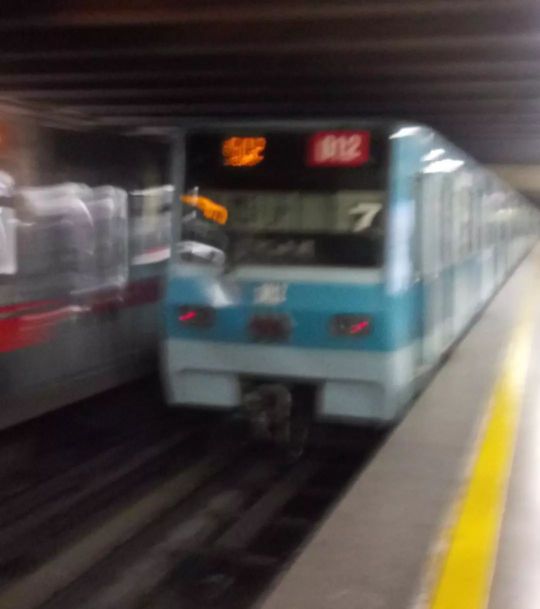
Tren Alsthom NS-74 P3012 (overhaul) saliendo de estación Plaza de Armas del Metro de Santiago de la Línea 5, con destino a Vicente Valdes. Es el tercer tren overhaul de los NS-74 que circuló por Línea 5. R.515 Metro de Santiago Plaza de Armas (L5) Alsthom NS-74 P3012 #Hastag #MetroDeSantiago #MetroSantiago #Metro #InstaMetroDeSantiago #InstaMetro #Alstom #NS74 #Overhaul #PlazadeArmas #Línea5 #L5 #InstaTren #InstaSantiago #InstaStgo #Santiago #Stgo #Instagram (at Plaza de Armas) https://www.instagram.com/p/CeKFLP5roxL/?igshid=NGJjMDIxMWI=
#hastag#metrodesantiago#metrosantiago#metro#instametrodesantiago#instametro#alstom#ns74#overhaul#plazadearmas#línea5#l5#instatren#instasantiago#instastgo#santiago#stgo#instagram
0 notes
Video
CP 2627_Cº 31200/1_São Gemil_02-09-2021 von Gil Ismael Braga Monteiro
Über Flickr:
Marcha de ensaios das carruagens Arco, procedente de Guifões e com destino a Valença.
#Águas Santas#Porto#Portugal#CP#2620#2627#Alsthom#Sorefame#Carruagens#Ex-Renfe#Arco#Ensaios#31200/1#Guifões#Valença#São Gemil#Linha de Leixões#Recuperação#Oficinas#EMEF#Infraestruturas de Portugal#flickrTravelAward#Comboio
25 notes
·
View notes
Photo

Hola a todos 😀 les dejo esta foto tomada de un #Alsthom del 73 una de las primeras maquinas del metro de #Santiago #ContestDemia #contestdemia #tren #subway #metro @photodemia_ @amosantiago (en La Cisterna (estación)) https://www.instagram.com/p/B1byPHIhsMY/?igshid=1urbpbphms4sa
0 notes
Photo
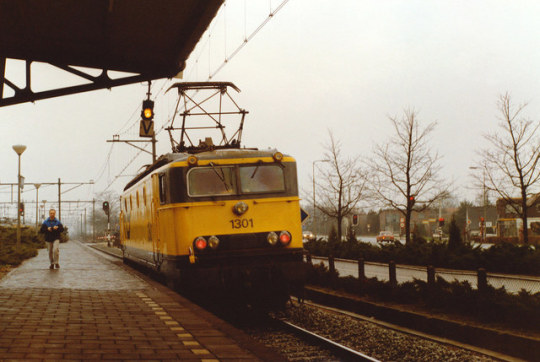
1301 by lex_081 De 1301 verlaat het station van Dieren richting Zutphen, nadat even daarvoor het gemeentewapen van Rheden (met daaronder de naam Dieren) is onthuld. Woensdag 6 december 1989. https://flic.kr/p/2gnL9Ej
0 notes
Photo



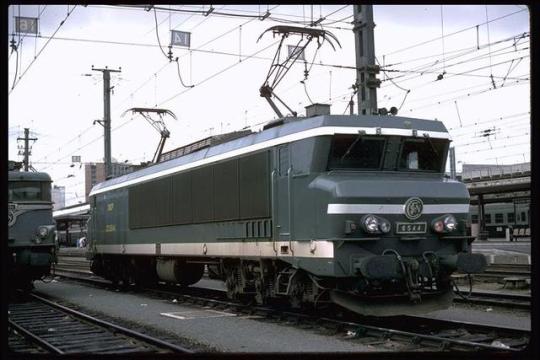
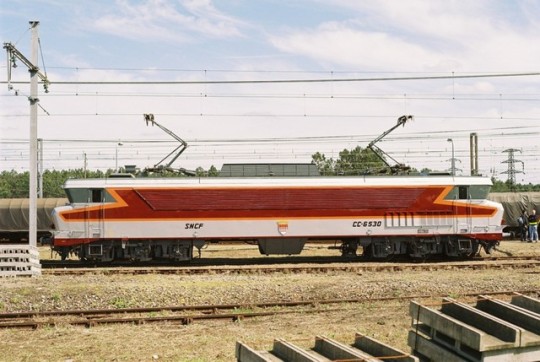





The SNCF "Nez Cassé" family of electric locomotives.
Class CC 6500 is a 1.5 kV DC electric locomotive .
Class BB 7200 is a 1.5 kV DC electric locomotive .
Class BB 15000 is the 25 kV AC version
Class BB 22200 is a dual-voltage version. (They are numbered to show that the DC and AC class numbers add up to the dual-voltage locomotive class number (7200 + 15000 = 22200).
Class CC21000 is a 1.5 kV DC + 25 kV AC electric locomotive.
Class CC40100 is a 1.5 kV + 3 kV DC + 15 kV + 25 kV AC electric locomotive.
1 note
·
View note
Video
Ecuador Diesel Riobamba by Neil Smith
Via Flickr:
9 Sep 2003 G&Q GEC Alsthom Bo-Bo-Bo 2409 (1992) and coach 212 in Riobamba depot. Guayaquil & Quito Railway, Riobamba, Ecuador.
1 note
·
View note
Photo
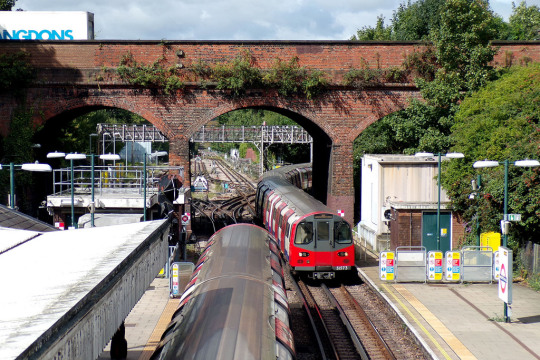
London Underground Northern Line GEC Alsthom 1995 Stock number 51573 arriving at Finchley Central Station.
If you would like to view more London Underground Northern Line 1995 Stock, please check out the LS Photography website at https://lessavine.co.uk/london-underground-northern-line-1995-stock/
#LondonUnderground#LondonTube#Tube#Underground#Metro#NorthernLine#GECAlsthom#1995Stock#95rStock#RailwayPhotography#LSPhotography#Lessavine
1 note
·
View note
Video
Locomotora Alsthom 8018 060 DB por 🍻 📷 Fernando Dewey
Por Flickr:
Año de fabricación, 1957 Ubicada en el Ferroclub de Escalada Ficha técnica: portaldetrenes.com.ar/ficha/lkd026
4 notes
·
View notes
Photo

⬇️ OPEN THE DISCRIPTION PLEASE / OPEN DE BESCHRIJVING ALSTUBLIEFT / ÖFFNE DIE BESCHREIBUNG BITTE ⬇️ ▪️▪️▪️▪️▪️▪️ 🇳🇱/🇧🇪 ▫️ ▫️ Door werksaamheden kwam deze Thalys des eerste generatie richting Amsterdam Centraal door de fotoplek in Dordrecht-Zuid ▫️ ▫️ ▪️▪️▪️▪️▪️▪️ 🇬🇧/🌍 ▫️ ▫️ Becouse of people working at the tracks this TGV/Thalys got a different route and here it passes as a Thalys to Amsterdam Centraal here past the photoplace in Dordrecht-Zuid ▫️ ▫️ ▪️▪️▪️▪️▪️▪️ 🇨🇭/🇩🇪/🇦🇹 ▫️ ▫️ Durch bauarbeiten kam hier ein TGV/Thalys der erste generation vorbei mit der Thalys richtung Amsterdam Centraal vorbei der fotostelle in Dordrecht-Zuid ▫️ ▫️ ▪️▪️▪️▪️▪️▪️ 🌍 -- Thalys / SNCF -- 🌍 ▪️▪️▪️▪️▪️▪️ 🚂 GEC Alsthom TGV PBA 🏁 Thalys - Paris-Nord -> Amsterdam Centraal 🛤 Dordrecht-Zuid, ZH 📆 Datum 📸 Canon EOS 250D 🎛 Adobe Lightroom ▪️▪️▪️▪️▪️▪️ ▫️ ▫️ ▪️▪️▪️▪️▪️▪️ 🌐 PARTNERPAGES 🌐 🔻 Gerne alle Followen 🔻 @erichgillard @sbb_trains @zugwelt_schweiz @trainspotterhuttu @railwayphotos_tiziano @trainspotter_burgdorf @swisstrainspotting @swisstransportation @photostrainssuisse @trainspotter_seeland @trainspotter_by_sam @tp.spotter @gotthard.nordrampe @swiss_trainspics @eisenbahnbilder_de @trainspotting_spreewald @trainspotter_schluchsee @trainspotter_594 ▪️▪️▪️▪️▪️▪️ ▫️ ▫️ ▪️▪️▪️▪️▪️▪️▪️▪️▪️▪️▪️ ⬇️ Hashtags ⬇️ #trainspotting #trainspotter #Thalys #PBA #TGV #SNCF #bahnbilder #railway #holland #nederland #eisenbahnromantik #treinspotter #eisenbahnfotografie #trainpictures #trains #trainspottingpictures #trainstagram #railstagram #trainphoto #trainsofinstagram #züge #frenchtrains #FrenchTrainPics #Rail #treinleven #Trainpics #railways_of_our_world #railways_worldwide #treinfotografie #treinspotten ▪️▪️▪️▪️▪️▪️▪️▪️▪️▪️▪️ @thalys @sncf (hier: Dordrecht) https://www.instagram.com/p/CRW7WpzLoT-/?utm_medium=tumblr
#trainspotting#trainspotter#thalys#pba#tgv#sncf#bahnbilder#railway#holland#nederland#eisenbahnromantik#treinspotter#eisenbahnfotografie#trainpictures#trains#trainspottingpictures#trainstagram#railstagram#trainphoto#trainsofinstagram#züge#frenchtrains#frenchtrainpics#rail#treinleven#trainpics#railways_of_our_world#railways_worldwide#treinfotografie#treinspotten
2 notes
·
View notes

